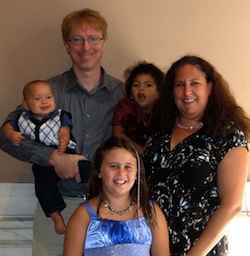“Dad, where is the core of the house?” the youngest asked me this morning, as I made his lunch for school.
I might’ve answered differently if he’d asked me what, but this was specifically where. Still, I wanted to be sure what he meant, so I asked what he meant by “the core.” It turned out that, as I thought, he wanted to know the location of the center of the house, like the core of an apple.
I didn’t ask why he wanted to know. I try not to, in cases like this, although sometimes I say something like, “Why do you ask? It’s okay that you want to know, I’m just curious about what led to that question.” But I try to reserve that for questions that seem like they could lead to dangerous activity — e.g., “What would happen if I jumped off a roof?” (Which, to be clear, I don’t think he’s ever asked, but if he did, I’d answer his question seriously and then ask why he wanted to know.)
This time, I just said, “It’s a good question! Let’s figure it out.”
First I had him determine which was wider, the living room or the dining room. He counted off steps and determined the living room was wider. Then he counted the steps across the front hall (such as it is), and then added up the steps from the three spaces. They had been big steps, so it was 18 steps across the house.
More steps were taken to measure the house front to back, at which point we figured out that the center was somewhere in the main stairwell. (Also the only stairwell.) But then I threw the curveball: we’d measured the house side to side and front to back. What else had to be measured?
He thought hard a moment, and then he got it. The slow-blooming grin on his face was priceless. Then he laughed. “How am I supposed to count steps from the basement to the attic?!? I can’t walk in the air, of course!!”
So we counted the floors and their heights in our heads, and considered that the roof’s peak was a bit higher than the attic ceiling, but that the attic and basement had lower ceilings than the first and second floors. In the end, we decided the core of the house was probably the step just below the first landing of the stairwell, about two-thirds of the way across it. He sat in that spot, looking pleased and maybe a little smug. Then he slid down the stairs, telling me his head felt weird when he thought about how he was sitting in the exact center of the house.
A few minutes later, he’d hauled out the deluxe snap circuit set his uncle had gotten him for Christmas, and was building a circuit of his own making. Once it was completed, we talked about current flows and why the fan went slower and the light came on when he opened the switch, and the light went off and the fan sped up when it was closed.
And then it was off to kindergarten. As we walked up the street, he asked why a leaf had moved closer to the door when he slammed it shut instead of being blown further away, so we talked about fluid displacement. The conversation lasted until he spotted a friend getting out of a car, at which point he ran off to compare outfits. (Today was Pajama Day at the school.)
I love talking with him about the world and how it works, because it lets me see the world through new eyes. I felt the same way when I had the same kinds of conversations with his sisters. It’s a cliché that a small child constantly asking “Why?” is annoying and exasperating, but not to me. I never, ever want them to stop asking why. I will always answer their questions, or tell them I don’t know and we’ll find out together. The internet makes that last part much, much easier than in the past, admittedly.
I have another reason to always give an answer, though.
If I always answer my childrens’ questions, I teach them that questions are okay, that questioning is a good thing. And more importantly to me, I teach them that they can come to me with anything, and be taken seriously. Kat feels and acts the same, thankfully.
This has been a real advantage with our eldest, as she moves through middle school and into her teenage years. She knows she can be honest with us. More than once, she’s come to us with serious situations in her peer group, and known that we will listen, take her concerns seriously, and will act as needed. She’s… well, I don’t know if she’s exactly comfortable discussing the biological ramifications of growing up, but she’s able to do so without hesitation or shame. Because she knows I’ll take her seriously, and listen to her, and not tell her she’s wrong or inappropriate. A lifetime of answering her questions about ice and airplanes and the Moon and the color of the sky taught her that.
Always listen. Always give an answer, even if it’s “I don’t know.” Always take them seriously.
Because one day, that open door may give them a place to go for help and shelter, right when they most need it.

